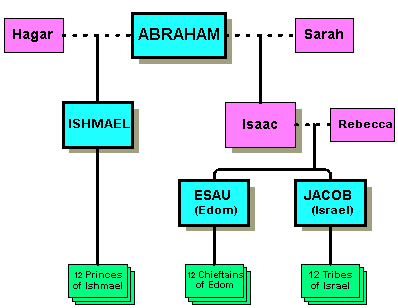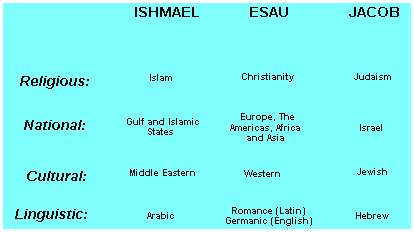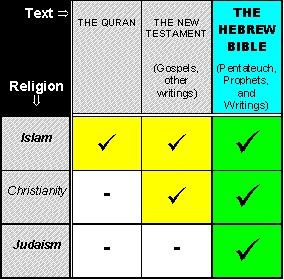| TheSong of the Dove |    |
  |
| TheSong of the Dove |    |
  |



The Middle East: Holy Ground or Battleground?
For the billions of adherents to the three major monotheistic religions of the world - Islam, Christianity, and Judaism - the Middle East is holy ground. At the same time, it is their most famous battleground. Today, the entire region is bristling with weapons of mass destruction, making the Middle East one of the most volatile and dangerous places in the world.
The Peace Process
Beginning about 1990, a new international relations initiative, the Peace Process, began to take shape in the Middle East. Much of the world community heralded the start of a new era. Yet true security for the various national and religious groups in the Middle East remains elusive, and the threat of a devastating outbreak of comprehensive regional war has actually increased over time. Perhaps the reason for this dilemma is that the current peace process does not really grapple with the underlying issues that make the Holy Land such a hot spot.
The Struggle for the Holy Land
Although the conflict in the Middle East is generally perceived of as a national one, pitching the Arab states against Israel, there exists an additional dimension to the conflict: the religious component. The Middle East is the cradle, stage, and evening news backdrop for Islam, Christianity and Judaism, the world's three major monotheistic religions. No analysis of the area could be complete, and no peace process will reach true success, without factoring in the clash of the three great religions in the complex mosaic of competing interests that is the Middle East.

In order to understand the real dynamics of the region, it is useful to peel back the age-old layers of antagonism to arrive at the original patrimony that is shared by the three major monotheistic religions:
A Common Ancestor: Abraham
In the narratives of the Bible, we see that a common ancestor exists for each of the three world monotheistic faiths: Abraham the Patriarch.Through Abraham, the physical and spiritual origins of each of the three monotheistic movements can be traced to a distinct personality appearing in the Pentateuch (the first portion of the Bible, the text shared by each of the three beliefs).
The source personality of Judaism is Jacob the Patriarch. It is widely accepted, by Jews and non-Jews alike, that the Jewish People are descended from Jacob, grandson of Abraham the Patriarch. In fact, the very name of the nation, Israel, is actually an alternate name of Jacob.
Similarly, the Biblical source personality of Islam is Ishmael. Islam as a national movement traces its origins to Ishmael, who was the first son of Abraham through Hagar, the Egyptian maidservant that Abraham took as a wife. Adherents to Islam as well as members of the Arab national entity are sometimes known today as Ishmaelites.
Christianity also has a source personality in the immediate descendants of Abraham. There is a tradition, widely mentioned in post-biblical exegetic writings, that Esau (a second grandson of Abraham and the twin brother of Jacob) is a much earlier, biblical figure in the Christian ethos.1
In fact, it is understood by Jewish and Christian commentators alike that Esau, also called Edom in the Bible, was the national ancestor of the Roman nation, and therefore the progenitor of Christianity.2
Each of these three related biblical figures, Ishmael, Esau and Jacob, was entered into the pact of circumcision during Abraham's lifetime because of their close connections as blood relatives of Abraham himself. As contemporaries and members of the same extended family, Ishmael, Esau and Jacob were intimately familiar with one another. And as the leading members of Abraham's household, all three absorbed from Abraham the core teachings of the faith in the One Lord, the dissemination of which was Abraham's life work. See the figure "Abraham's Family Tree", below.

In Abraham, therefore, each religion has a single, common ancestor, in the physical as well as the spiritual sense. Moreover, each of Abraham's leading descendant personalities goes on to found familial, cultural and spiritual dynasties of their own, in each case in groups of 12 descendant entities. Ishmael is the ancestor of 12 princes; Esau, of 12 chiefs and their corresponding territories of dominion; while Jacob is the forefather of the 12 tribes that together comprise the nation of Israel. See the following figure, "The Cultural Heritage of Abraham's Descendants."

National Origins in the Holy Land
Since the three biblical personalities behind the major monotheistic religions are closely related, it shouldn't come as a surprise that each of them has origins in the same geographical location. Ishmael was born while Abraham was living in the south of what at that time was called the Land of Canaan; Jacob and Esau were born in the very same area a generation later.This land, also famous as the Promised Land of the Bible, plays a central role in the drama of the Biblical story. The Lord appears numerous times throughout the Biblical narrative, promising this land to Abraham and his successor descendants for all time.
When it is understood that all this flows from Abraham, it becomes clear why each of the three religions views this tiny area of land perched between the continents of Eurasia and Africa as sacred. This is also the reason why the main regional cities mentioned in the Bible are considered holy to each of the three religions.
Reverence for The Bible
Each of the three religions is connected with a particular body of sacred scriptures. Judaism's book is the Hebrew Bible; Christianity, the New Testament; and Islam, the Quran. The following figure, "Attitudes of the Three Major Monotheistic Religions to Each Other's Writings", illustrates the attitudes of each religion towards these three collections of writings, with a check mark indicating official reverence for a particular writing:

Here we see that the core holy text, revered by Islam, Christianity and Judaism alike, is the original Hebrew Bible, comprising the Pentateuch, Prophets, and additional Writings.
Are Ishmael, Esau and Jacob Relevant To Us Today?
At this point, the reader might ask: "So what if the world's main monotheistic religions are related in some way, and stem from a single source? This may be interesting from a theoretical standpoint, but how does it help us understand the complex geopolitical puzzle of today's Middle East?"The answer is that the Bible gives us an unparalleled opportunity to understand things, through a two-step process:
First, let us assume that the descendants of these three pivotal individuals, Ishmael, Esau and Jacob, are still on the scene, delineated by religion, nation, language group and world culture. Furthermore, they continue to be locked in conflict with one another. It follows that by understanding the Biblical figures and how they interacted with one another in their lifetimes, we can develop a clearer picture of the factors that fuel the international conflicts of our own troubled times.
Second, when we really understand the roots of the conflict, then we can begin to visualize a true and comprehensive solution, one that will last beyond the next war, coup-détat, or elections. Furthermore, if as assumed, the Bible is so excellent a resource for arriving at a realistic picture of the struggles in today's volatile Middle East, then perhaps it is reasonable to expect that this very same book, accepted as true and worthy of reverence by Islam, Christianity and Judaism alike, might contain the keys to solving the conflict as well.
For a deeper look at the theory behind this idea, visit the Philosopher's Corner.
Come On In and Meet Your Family
Within the pages of this web site, you are invited to meet four pivotal Biblical family members: Ishmael, Esau and Jacob, and their common forebear, Abraham. Perhaps through them we can finally see what the fight is all about, and how we can arrive at a resolution that will make all the players satisfied in the end.We present the plain meaning of selected passages from the first book of the Bible, Genesis, translated from its original Hebrew into English. Accompanying each section of the Biblical text is a brief analysis meant to highlight the particular issues raised in a passage. By learning of the roots of the conflict as they express themselves in the on-going relationships of the descendants of Abraham, the reader may gain a sharper understanding of the geopolitical dimensions of the Middle Eastern conflict in our own times.
To get a feel for the nature of the sources used in developing the ideas of this web site, as well as the principles of translating original source texts into English, visit the Sources Reading Room.
FOOTNOTES:

1 Don Isaac Abarbanel, Commentary on the Prophets, Isaiah 35 (p. 169):
The basis for understanding this prophecy, and other prophecies that come in the words of the Prophets, is this: Rome, and all the people of Italy, and Christians in general, are from the descendants of Edom.
Maimonides (Rabbi Moshe the son of Maimon), The Letter to Yemen (Iggeret Teiman), published in "The Letters of Maimonides (Igrot HaRambam)", Mossad HaRav Kook, p. 21:
...And a long time after him [Jesus of Nazareth], a religion that was attributed to him spread through the Children of Esau [i.e., Rome and its empire] ...

2 The Chapters of Rabbi Eliezer (Pirkei d'Rebbe Eliezer), 38:
"And Esau took his wives and his sons and his daughters and all the members of his household, and his flocks and all his livestock, and all the property that he had acquired in the Land of Canaan, and he went to another land because of Jacob his brother" (Genesis 36:6-8) - As a reward for uprooting all that was his to make room for Jacob his brother, he was given 100 cities, from Seir until Magdiel, as it is said, "The Chief of Magdiel, the Chief of Iram" (Genesis 36:43) - this is Rome.







 GeoCities - Get your very own Free
Home Page!
GeoCities - Get your very own Free
Home Page!